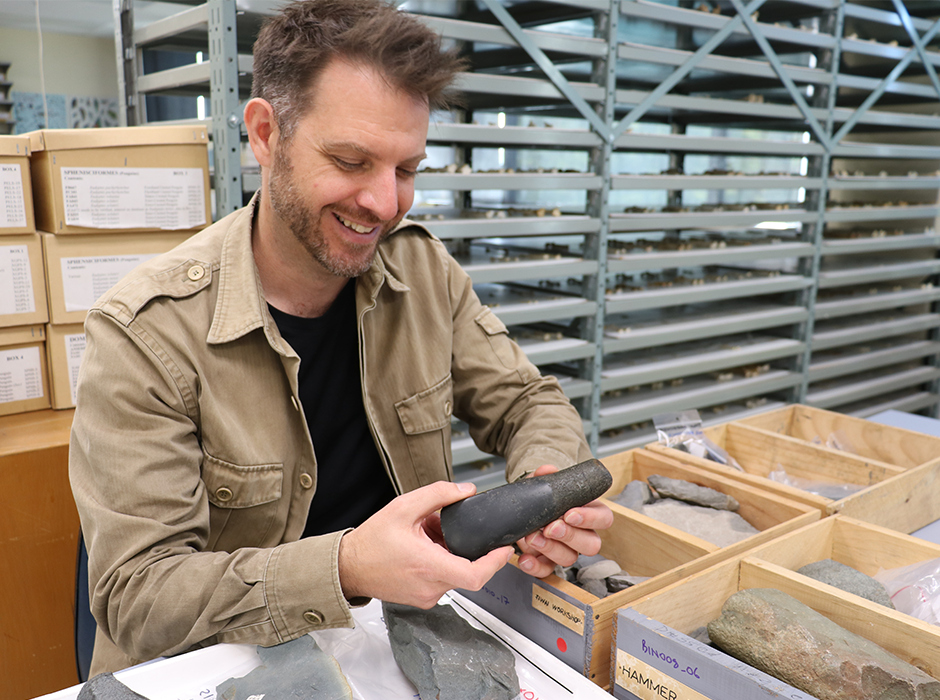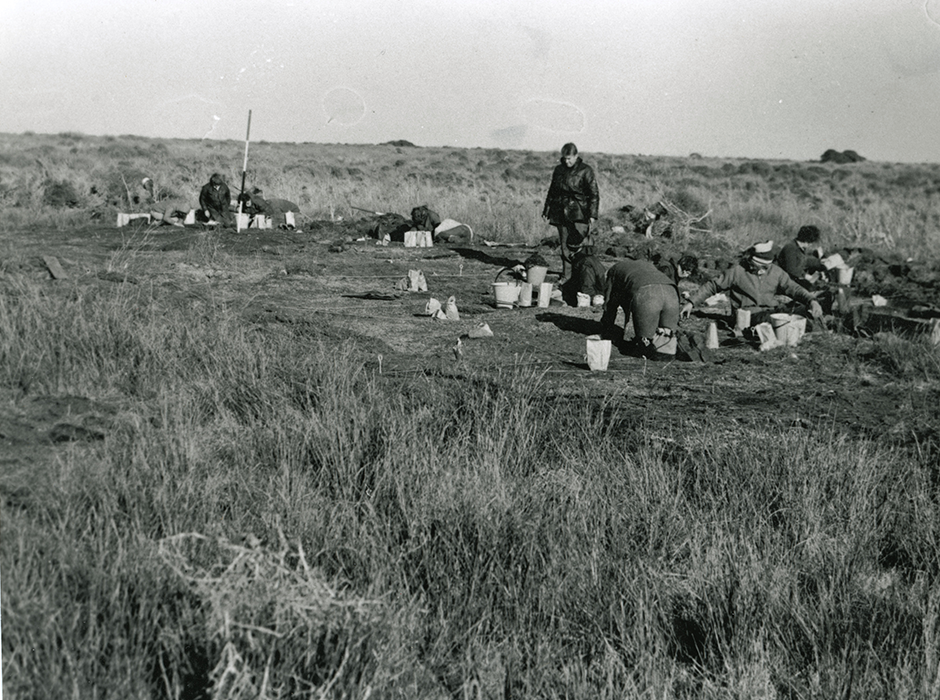
Southern Pacific Archaeological Research Senior Archaeologist Dr Chris Jennings holds a stone toki (adze) that was excavated from a 700-year-old settlement at Tiwai Point, Bluff.
For one Otago researcher, a decades-old archaeological project studying eleven tonnes of artefacts from Tiwai Point – including 700-year-old stone adzes – is a significant milestone in uncovering the lives of Aotearoa’s early Polynesian settlers.
Stone artefacts, faunal remains and other artefacts extracted from Tiwai, at the entrance to Bluff Harbour, have been in storage for 57 years and are now being transported from the former Southland Museum (now cared for by Te Kupeka Tiaki Taoka Southern Regional Collections Trust) to Otago Museum.
There the artefacts will be analysed, reviewed and catalogued by a small team led by Senior Archaeologist of Southern Pacific Archaeological Research Dr Chris Jennings at the University of Otago – Ōtākou Whakaihu Waka.
“The study of the excavated material will give us a greater understanding of the earliest human activity in the Bluff Harbour area and the Polynesian settlement of Aotearoa New Zealand,” says Dr Jennings, who studied material from the Tiwai Point site as a major part of his PhD thesis.
“Several projects have been undertaken by researchers since excavations of the site in 1968.
“These studies have indicated that Tiwai Point was a settlement that focused on toki (adze) production using local argillite sources. This was an industrial-level operation, and the toki produced there were distributed over the Southland and Otago regions, with some found at least as far north as Banks Peninsula.”
Extensive stone tool production at the site was sustained by hunting, fishing and shellfish gathering activities, he says.
“For me this is an incredible opportunity to continue the work done during my Masters of Anthropology at Otago and my PhD at the University of Queensland.”

University of Otago Archaeology staff and students carrying out the excavation at Tiwai Point, 1968. Source: Te Kupeka Tiaki Taoka Southern Regional Collections Trust.
While Dr Jennings had studied some of the partially completed and completed toki from Tiwai Point during his PhD research, it turns out that was only the tip of the iceberg in terms of the quantity of material collected from the site.
“This work will give us a much better understanding of how Aotearoa’s earliest Polynesian settlers explored the land, utilised its resources and sustained their society,” he says.
Along with a review of material which was also radiocarbon dated in 1976, a team of scientists and researchers will be collating all available documentation including photographs and newspaper articles, relating to Tiwai Point – as well as conducting interviews with the remaining archaeologists; museum assistants and volunteers who participated in the 1968/1969 archaeological field work.
Te Rūnaka o Awarua, the local Ngāi Tahu tribal authority, is leading the project with support from the University of Otago, Te Kupeka Tiaki Taoka Southern Regional Collections Trust, Rio Tinto and Otago Museum.
Rio Tinto, owners of NZ Aluminium Smelter (NZAS) and the site where the Tiwai Archaeological collection was excavated, is funding the first stage of analysis and research work.
Te Rūnaka o Awarua trustee Dean Whaanga says extracting new information from the stone artefacts is extremely important for the iwi.
“This will reinforce our whakapapa connection to our tūpuna, to Tiwai and how we used our resources.
“The material has been stored waiting for the right time and resourcing to have this mahi done,” he says.
Rio Tinto NZAS Manager of Communities and Social Performance Dion Williams says Tiwai Point is well known to the Southland community as the home of Rio Tinto’s Aluminium Smelter, since its construction back in 1971 when it was known as Comalco and was built in conjunction with the Manapouri Power Station.
“It’s fascinating to think that over 600 years ago it was also a thriving site of business where many toki (adzes) were produced, among other tools of industry.
“Our business is part of Southland’s past, present and future, and we want to play our part in acknowledging and raising awareness of a history here that can be dated back many centuries before us.”
The long-term plan on future ownership and storage of the Tiwai collection, and how it will be curated and displayed will be worked through by the Project Steering Committee, comprised of Te Rūnaka o Awarua, the University of Otago Archaeology Programme, Te Kupeka Tiaki Taoka Southern Regional Collections Trust and Rio Tinto.
Timeline of Tiwai archaeological discovery
1940s: Archaeological material located in, on and around the Tiwai Peninsula.
Early 1960s: Interest in the development of an Aluminium Smelter prompted an initial survey of Tiwai.
1966 to early 1968: Southland Museum Trust Board pushed for an excavation.
1968: Otago Anthropological Society, University of Otago, Otago Museum, and Southland Museum began an excavation of the site of the proposed smelter.
1969: Nearly 11 tonnes of material unearthed and stored as a research collection at Southland Museum (now Te Kupeka Tiaki Taoka Southern Regional Collections Trust).
1971: Comalco Aluminum Smelter opens at Tiwai Point. Around this time two University of Otago students audit some of the excavated material for the first time.
1976: Further radiocarbon dating is done on some of the excavated material.
2022 to early 2023: Initial audit of the excavated material is done by Southland Museum and Art Gallery staff.
2024: Rio Tinto agree to fund project to proceed.
2025: Tiwai Archaeological collections, including excavated material moves to Dunedin, where analysis will begin by the University of Otago.